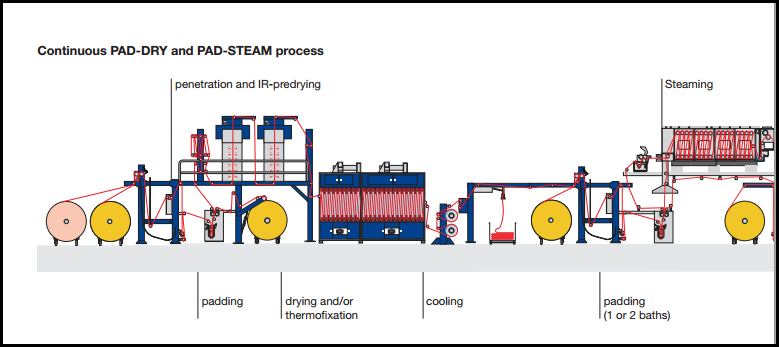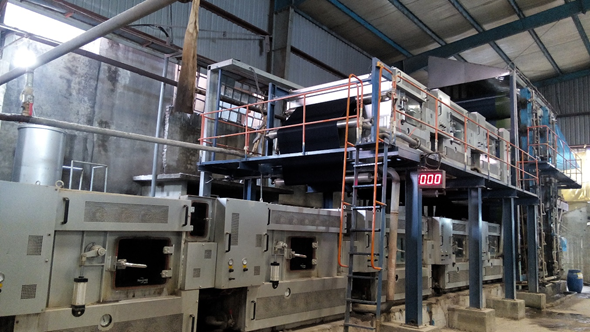What is Pad-Steam Dyeing Process?
Pad-Steam dyeing is a process of continuous dyeing in which the fabric in open width is padded with dyestuff and is then steamed. Pad steam is an ideal machine for reactive dyeing of cotton and its blended fabrics. Light, pale and medium shades can be dyed in this machine. Continuous roller steamer is used for diffusion of reactive, vat, Sulphur and direct dyes into cellulosic fibers in an atmosphere of heat and moisture that is created by saturated steam injected into the steamer.
What are the Purposes of the Pad-Steam Dyeing machine?
- It can be used as a pad batch for reactive dyeing in which batch is left for 12-18 hours for the completion of the reaction. For time saving the fabric passes through the steamer for 1 minute and the reaction is completed.
- It can also be used for reduction clearance (RC) in which we treat PC fabric with caustic and sodium hydrosulphide to remove the disperse dye from cotton.
- Stripping of the fabric can also be done on this machine that is, color can be removed completely by adding higher amount of caustic and sodium hydrosulphide.
- It can be used for the development of Vat dyes.
- The dyed fabric can be washed in this machine.
What are the Process that can be done with Pad-Steam Dyeing machine ?
- Reactive dyeing
- Pad-batch dyeing
- Reduction Dyeing
- Stripping
- Vat Development/ Vat Dyeing
- Hot and Cold Washing
- Pad Steam
What are the Main Sections of the Pad-Steam Dyeing machine ?
The main components are described below with details data.

1. Inlet Section :
Inlet section consist of Following Parts :
- Plaiter/batcher
- Tensioner rollers
- Free guide roller
- Stationary rollers
2. Padding Section :
- Padders use for padding.
- The pressure of the padders are 1.5 – 2 bar.
- Two types of pressure used in Kuster padders, hydraulic and pneumatic.
- The central pressure is hydraulic and side pressure is pneumatic.
- We can adjust the pressure of the padders, to prevent the listing problem.
- Liquor is picked in the fabric; afterwards the excessive liquor is squeezed out by means of padders at predetermined pick-up% set by applying pressure on the padders.
3. Steamer :
Here in steamer temperature required for the fixation is given to the fabric. This temperature is achieved by saturated steam. The purpose of using saturated steam is that the chemicals used for developing should not dry on the surface of fabric preventing fabric from stains. Here roof temperature is given to avoid water dropping that causes spotty dyeing. Here water is not given at the entry of steamer because to prevent developing chemicals that just applied before going into steamer so water lock is given at the end of steamer.
4. Washer:
Washing is carried out in order to remove unfixed dyes. After steamer fabric flows from 7 to 8 washers. Most commonly first to four washers are used for washing of salt or chemicals which are being applied in trough of pad steamer. In 5th, 6th washer, oxidation is done if required. If oxidation is not required then soaping is done in 5th, 6th washers. Neutralization is done in 7th washer by using acetic acid. There are 8 chambers counter flow system is used. The chambers are used for number of process a/c to the requirement of dyes by showering of different type of chemicals
5. Dryers:
In the last of the pad steam machine, there are three groups of drying cylinder for dry the fabric. Each group has 12 hot cylinders, but last one has 10 hot and 2 cool cylinders. All the cylinders are Teflon coated. Their purpose is to remove water molecules from fabric.
6. Batcher:
The fabric from drying cylinders passes through some tension rolls and also from anti-static rods which absorbs the charge from the fabric. This rod has 5 KV voltages and 1800-18000A of current after passing through this fabric is winded on the batcher.
Chemical uses in PDC:
For Cotton For Polyester
Wetting agent – 2g/L Dispersing agent – 2g/L
Anti migrating – 5g/L Acetic acid – 1g/L
Urea – 10g/L
What are the Advantages of Pad-Steam Dyeing machine ?
- Uniform liquor application over the whole fabric width.
- Different liquor application in the range of side-center-side zone is possible.
- Attractive price.
- Easily operation
- Reliable and economical
What are the Disadvantages of Pad-Steam Dyeing machine ?
- Difficult to make correction to off-shade batches .
- Process not viable unless high-quality machinery is used.
- Requires an intermediate drying process after bleaching
- Requires fabrics to have completely uniform moisture and temperature throughout to achieve optimum results.
Source :
- Based on “Industrial Attachment on Asian Textiles Mills Ltd” by Fatema Akter, Md. Kamrul islam, Jishan Ahmed &Al-Amin under supervision of Kawser Parveen Chowdhury, Lecturer, Department of wet Processing Engineering, Bangladesh University of Textiles.
- Image : https://textileinsight.blogspot.com

